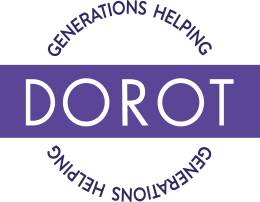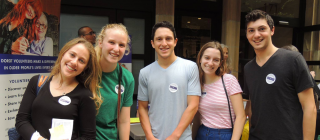5 Takeaways from 1,000+ Solo Agers
By Amy Stein-Milford, Director Onsite and Special Programs, DOROT
Who will help me if something goes wrong? That’s the burning question for older adults who live on their own.
As Helene W., a DOROT community member, said, “When my mother was becoming ill and incapacitated, I became what I call the CCEO, or Continuing Care Executive Officer of her life. I oversaw her finances, healthcare, legal matters, and home. Now I wonder, who will do that for me if I become ill? Who will pay my bills, represent me at the hospital, make sure my home is organized and my refrigerator is stocked? Who is my CCEO? Who is my Me?”
Like almost one-third of American adults over 55—22.1 million of us—Helene is a solo ager. She lives alone, with no spouse and no adult children able to take care of her. She is part of a growing community who, by choice or circumstance, expect to age or make decisions about their future independently.
Helene is also one of the 1,125 people who have participated in Aging Alone Together, DOROT’s flagship program for solo agers. Over six sessions, we tackle topics such as: Where will I live? How do I plan for an emergency? How can I strengthen my social and support networks?
Each week, we break into small discussion groups. Participants come from all over the country, with a wide range of backgrounds and financial situations. They share experiences, swap strategies, gain new perspectives, and recognize that, while they may be solo agers, they are not alone. Their exchanges are profound, humorous, vulnerable, empowering—sometimes all at once.
Here are five key insights that we have learned from the community of solo agers who have taken Aging Alone Together. They all relate to the question: “Who can I turn to for guidance, friendship, and help?”
1. Our Most Important Resource Is Other People
The number one resource that participants in Aging Alone Together rely on is not an organization or a how-to book or even our Resource Guide which lists over 100 national resources for solo agers—though all these things are useful! Time and again we hear this message: My most important resource is other people.
Susan S. found her accountant through a Mah Jong acquaintance. Robert M. found a physical therapist through his church. Karen R. said she finds community through DOROT. “Time and again, I turn to my social network. They may not be people I know intimately, but they are people I trust,” says Susan.
Solo ager Vivian Conan credits a contact she met in AAT for helping her find her new home. It was in Week 3, when we focus on Aging in Place, that she learned about a housing lottery that ultimately landed her an apartment on Manhattan’s Upper East Side.
Ah, you say! But I don’t have anyone to rely on. Then head on to Takeaway #2.
2. There are More People in Your Life Than You Realize
If you don’t have a strong network of support, know that you are not alone. Many people who take Aging Alone Together feel just that way.
We use a model called the Circles of Support to help people visualize their network, which is the first step in building it out. This exercise gets people thinking about the full range of people with whom they interact—relatives, friends, a neighbor, a doctor, your bowling buddy, a shopkeeper with whom you do business. A dog walker, too!
There are likely more people in your life than you realize. Using the Circles of Support is a great way to recognize your contacts, visualize where you can strengthen an existing connection, and pinpoint an opportunity for meeting new people.
As Rita C, an Aging Alone facilitator, points out, “As we know demographically, there are more and more older adults every day and, when we look, we find ourselves surrounded by solo agers, just like ourselves. I find it comforting to share similar needs with so many others.”
3. Discover the Camaraderie of “Third Places”
The concept of “Third Places” comes up a lot in Aging Alone Together, though people aren’t always familiar with the term.
Third places are locations and organizations that facilitate interaction outside of home and work (your first and second places). Just think of Monk’s Café in Seinfeld, Jerry’s perennial hangout. A Third Place could be your local coffee shop, bar, library, house of worship, or community center. DOROT is also a Third Place! For AAT participant Lester S., the theater is his Third Place, where he meets like-minded people. Third Places don’t need to be physical spaces. Zoom classes, virtual book clubs, internet game sites are great ways to connect, particularly if you are home-based.
4. Keep an Eye Out for Invitations
You may feel like you have no one to turn to. But you likely have more invitations than you realize. By “invitation,” we mean all the ways you are invited to do something or be with people.
Ask yourself:
- What do I like to do for fun?
- What do I want to learn more about?
- What new skill do I want to learn?
- What new activity do I want to try?
- Is there a cause or organization I want to volunteer with?
Newsletters, bulletin boards, and websites from trusted organizations are a great source of invitations. (May we plug our Weekly Program Email? You will find fitness classes, art and culture programs, Aging Well sessions, and tons of other events, all free, and with both Zoom and in-person options.) Check out your local news source or political representative—they may have a newsletter that lists events in your neighborhood. These are great ways to meet other people who live nearby and who share similar interests.
At DOROT, we even have a teleconference program that delivers all kinds of classes and discussion groups for those who prefer using their phone.
You can choose from an abundance of invitations, if you recognize them.
5. Remember: Solo Aging Doesn’t Mean Aging Alone
We say this a lot. We like the idea so much we made it one of our Aging Alone Together mantras. (There are three mantras. You need to take our curriculum to learn the other two.) As Karen R. says, “Five percent of the time it’s scary. Fifteen percent of the time it is tolerable. Eighty percent of the time it’s wonderful.”
While we don’t pretend to have all the answers—Helene W. continues to look for “that person to put on her refrigerator,” a trusted person who can represent her wishes should she become ill—through Aging Alone Together we offer community, resources, and strategies garnered from the experiences of other solo agers.
Want to learn more about solo aging? Join DOROT on Zoom on Wednesday, May 14, for our Solo Aging Visibility Day (SAVvy Day) programs. SAVvy Day is dedicated to bringing attention to the growing community of solo agers and advocating for their needs and interests.




